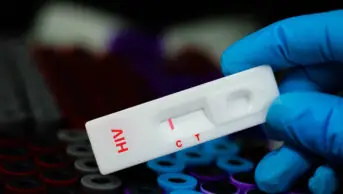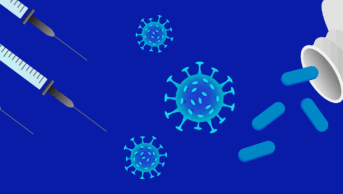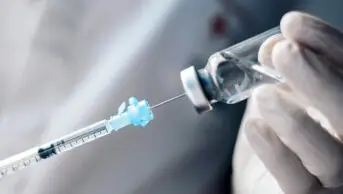The AIDS epidemic was first described by the US Centre for Disease Control in 1982 following the study of clusters of young homosexual men in New York, Los Angeles and San Francisco who presented with cases of pneumocystis pneumonia (PCP) and Kaposi’s sarcoma. HIV, the agent that causes AIDS, was isolated in Paris in 1983.1 Health Protection Agency data from 2009 in the UK estimate there are 86,500 people living with HIV, with 25 per cent unaware of their condition.2
Biology
HIV is a member of a large family of retroviruses (viruses that store their genetic information as RNA, which is converted into DNA in order to replicate).3
There are six phases in the replication cycle of HIV:
• Receptor-mediated fusion and penetration
• Preparation of complementary DNA (cDNA)
• Integration of cDNA into the host’s genome
• Transcription (using the host cell’s machinery)
• Translation of the viral protein (again, this function is performed by the host cell’s machinery)
• Virion maturation and release
Viral binding and entry is a complex process. There are still many gaps in our knowledge of this.4Viral binding and entry requires two viral glycoproteins (gp120 and gp41) and appears to involve three cellular proteins: a primary receptor, CD4 (glycoprotein receptor found on the surface of a number of immune cells); a chemokine coreceptor (CCR5 or CXCR4); and the oxidoreductase protein, protein disulphide isomerise (PDI). Gp120 attaches to the CD4 receptor and induces a major conformational change within gp120, which facilitates binding with the co-receptor. Recent data have suggested a role in this process for the enzyme PDI, which catalyses the reduction, formation and isomerisation of disulphide bonds. The gp-120-chemokine binding causes conformational changes within gp41, which results in the fusion of the virus and the cell membrane.
The processes of cDNA preparation, integration and maturation rely on three enzymes, which are present within the viral capsid (protein coat surrounding the viral genome). The cDNA is prepared from viral RNA by the enzyme reverse transcriptase (RT) and integrated into the host genome by the enzyme integrase. During maturation, a single protein, known as the Gag-Pol fusion protein, which is the product of translation, is cleaved by the enzyme protease to generate the three viral enzymes.
Current treatment options
There are currently six different classes of antiretroviral drug available to try to suppress the HIV virus: four classes attack the three essential viral enzymes and two classes target both viral entry and fusion.5
NRTIs
Nucleoside reverse transcriptase inhibitors (NRTIs) block the action of RT and are converted in vivo to active agents by phosphorylation, exerting their effect by terminating transcription by acting as stop nucleotides.
There are seven licensed drugs in this category: lamivudine (3TC), abacavir (ABC), zidovudine (AZT), stavudine (D4T), zalcitibine (ddC), didanosine (DDI) and emtracitibine (FTC). There are also a number of combination tablets containing two NRTI drugs, which can reduce the pill burden of patients: Combivir (AZT and 3TC), Kivexa (ABC and 3TC) and Truvada (TDF and FTC).
NNRTIs
The first non-nucleoside reverse transcriptase inhibitor (NNRTI) to be introduced was nevirapine in 1996 and there are now two more members of this class available (efavirenz and etraverine). As a group, the NNRTIs are structurally diverse, although they all bind to RT at the same hydrophobic pocket that is close to the enzyme’s active site. The binding induces a conformational change in the protein, which is the basis of their inhibitory action.
PIs
Protease inhibitors (PIs) inhibit the viral protease enzyme, thus preventing the cleavage of the Gag-Pol protein.
The PIs that are currently licensed include atazanavir, darunavir, fosamprenavir, indinavir, ritonavir, saquinavir, tipranavir, and a combination pill containing lopinavir with ritonavir (Kaletra). Frequently, members of this class are given with a low dose of ritonavir (so-called boosted PI regimen). Ritonavir is a potent inhibitor of a number of cytochrome p450 isozymes, which are responsible for the metabolism of the PIs.
Integrase
Currently, a single integrase inhibitor, raltegravir, is licensed in this class.
CCR5 antagonists
Maraviroc is a CCR5 receptor antagonist that inhibits the binding process, hence stopping viral entry to the cell. However, because HIV also uses another chemokine receptor (CXCR4), the treatment is reserved for patients who express the CCR5 receptor as determined by tropism testing.
Fusion inhibitors
Enfuvirtide is a polypeptide that is administered by subcutaneous injection. It binds to gp41 and prevents the virus from fusing with the cell membrane.
Patients are treated by using three drugs ofmultiple classes of compound in a therapeutic strategy known as highly active antiretroviral therapy (HAART). In the UK, the guidelines published by the British HIV Association (BHIVA )6 suggest that, for those patients with an established infection, treatment should be considered when their CD4 count drops below 350 cells per μl. Treatment should be considered above this CD4 threshold in the following circumstances:
• AIDS diagnosis or HIV-related co-morbidity
• Hepatitis B infection where treatment is indicated
• Hepatitis C infection where treatment is deferred
• CD4 percentage of less than 14 per cent
• High cardiovascular risk
• Patients diagnosed with lymphoma starting chemotherapy
• HIV discordant couples
Treatment naive patients should be considered first line for an efavirenz-based regimen, with a NRTI backbone of Truvada or Kivexa.
Abacavir in Kivexa has a high rate of hypersensitivity reactions in patients who possess the HLA-B gene HLA-B*5701, so should not be used in these patients.
Kivexa should be used with caution in patients with viral loads >100,000 and cardiovascular risk >20 per cent over 10 years. Nevirapine is an alternative in women with CD4 counts <250 cells/mm3 and in men <400cells/mm3. Higher incidence of liver toxicity exists if used outside these CD4 thresholds.
A protease-based regimen should be considered second line, but considered if primary RT resistance is suspected, a woman intends to become pregnant (efavirenz is not recommended in early pregnancy) or significant psychiatric problems exist (efavirenz can cause neuropsychiatric side effects). PIs are normally used as part of a boosted regimen because this increases drug exposure, decreases dose frequency, decreases pill burden and reduces the risk of resistance emerging. Recommended PIs include boosted lopinavir, atazanavir, fosamprenavir and saquinavir.It should be noted that significant trial data have been published since the 2008 BHIVA guidelines were published.
The latest 2011 Department of Health and Human Services7 guidelines recommend starting treatment in naive patients at CD4 counts between 350 and 500 cells/mm3 and considering treatment in patients with CD4 counts >500 cells/mm3. Data also exist for the use of boosted darunavir, raltegravir and maraviroc in treatment-naive patients.7
In the UK, where 50 per cent of new diagnoses are late presenters (CD4<350 cells/mm3)2, strategies are needed to improve earlier diagnosis before patients can benefit from apparent or real benefits of earlier treatment.6
Research and development
Following the successful introduction of maraviroc, a number of small-molecule CCR5 antagonists are being investigated. Vicriviroc is the most advanced example and is currently in phase III trials.8
The humanised monoclonal antibody PRO-140, which is being developed by Progenics Pharmaceuticals, has been shown to have a number of favourable characteristics in a series of phase II trials. It is thought to bind competitively to a hydrophilic extracellular region of CCR5, thereby inhibiting HIV-1 entry and, because of the low concentration required for activity (25nM), does not affect the natural chemokine receptor activity of CCR5. In addition, when administered with enfuvirtide and a number of experimental CCR5 antagonists (ancriviroc, vicriviroc and TAK-779), the resulting synergistic interaction allowed five- to 10-fold dose reductions.9
GS-9350 is a non-PI cytochrome 3A (one of the major isoforms of cytochrome P450) inhibitor being developed by Gilead Pharmaceuticals, which appears to have a better safety profile compared with ritonavir.10 GS-9350 is also being examined as part of a number of co-formulations under development by Gilead, including the socalled “quad pill” (phase III trial; tenofovir/emtricitabine/elvitegravir/GS- 9350).11
An interesting approach is being pursued by Koronis Pharmaceuticals, which are looking at “viral fitness” as an approach to target the HIV virus. Viral fitness12 is defined as “the replicative adaptation of a virus to its environment” and results in a large degree of intrahost variability with RNA viruses, which, due to the high mutation rates (10–3 to 10–5 base substitutions per nucleotide copied), exist as a dominant genome (master sequence, or “most fit”) with a range of variant genomes. This population of competing genomes contains a range of variants with different mutation rates. High mutation rates introduce a large degree of genetic variability, but carry the risk of forming lethal variants (ie, variants that are not able to replicate efficiently) whereas low mutation rates mean possible immune recognition.
KP-121213 is a nucleoside that is incorporated into the cDNA and, because of the “un-natural” base component, is able to pair with both guanosine and adenosine (via its so-called “imino tautomer”), causing an increase in the rate of viral mutation.
The hope is that, due to a build up of variants that are not able to replicate effectively, there will be a collapse in the viral population.
In addition, this strategy offers the possibility of targeting the viral reservoirs because, as the reservoirs are reseeded, they will be reseeded with mutated variants.
Conclusion
Progress over the past 25 years has seen HIV move from a fatal to a chronic condition. There are still a number of challenges ahead and a real need for new approaches, for example, the ability to wipe out viral reservoirs might bring the possibility of a cure closer.
References
1. Barré-Sinoussi F, Chermann JC, Rey F, Nugeyre MT, Chamaret S, Gruest J et al. Isolation of a Tlymphotropic retrovirus from a patient at risk for acquired immune deficiency syndrome (AIDS). Science 1983;220:868–71.
2. HIV in the United Kingdom, November 2010, Health Protection Agency.
3. Wagner EK, Hewlett MJ. Basic virology, 2nd edition. Oxford: Blackwell Publishing; 2004.
4. Ryser HJP, Fluckiger R. Progress in targeting HIV-1 entry. Drug Discovery Today 2005;10:1085–94.
5. NAM aidsmap HIV treatments directory 29th edition 2011. Available at: www.aidsmap.com (accessed 3 June 2011).
6. BHIVA treatment guidelines writing group. British HIV Association guidelines for the treatment of HIV-1-infected adults with antiretroviral therapy. HIV Medicine 2008;9:563–608.
7. Panel on Antiretroviral Guidelines for Adults and Adolescents. Guidelines for the use of antiretroviral agents in HIV-1-infected adults and adolescents. Department of Health and Human Services. 10 January 2011:1–166. Available at: www.aidsinfo.nih.gov (accessed 3 June 2011).
8. Tilton JC, Doms RW. Entry inhibitors in the treatment of HIV-1 infection. Antiviral Research 2010;85:91–100.
9. Temesgen Z. PRO-140. Drugs of the Future 2009;34:789–92.
10. Nijhuis M, Wensing AMJ, van Maarseveen NM. Fifteen years of HIV protease inhibitors: raising the barrier to resistance. Antiviral Research 2010;85:59–74.
11. Study of the safety and efficacy of elvitegravir/emtricitabine/tenofovir disoproxil fumarate/GS-9350 (QUAD) versus atripla(R) in HIV infected antiretroviral treatment-naive adults. Available at: www.clinicaltrials.gov (identifier NCT 00869557) (accessed 3 June 2011).
12. Clementi M, Burioni R. Is reduction of viral fitness a valid antiviral approach? Drug Discovery Today 2007;4:267–72.
13. Mullins JI, Heath L, Hughes JP, Kicha J, Styrchak S, Wong KG et al. Mutation of HIV-1 genomes in a clinical population treated with the mutagenic nucleoside KP1461. PLoS ONE 2011;6:e15135.


